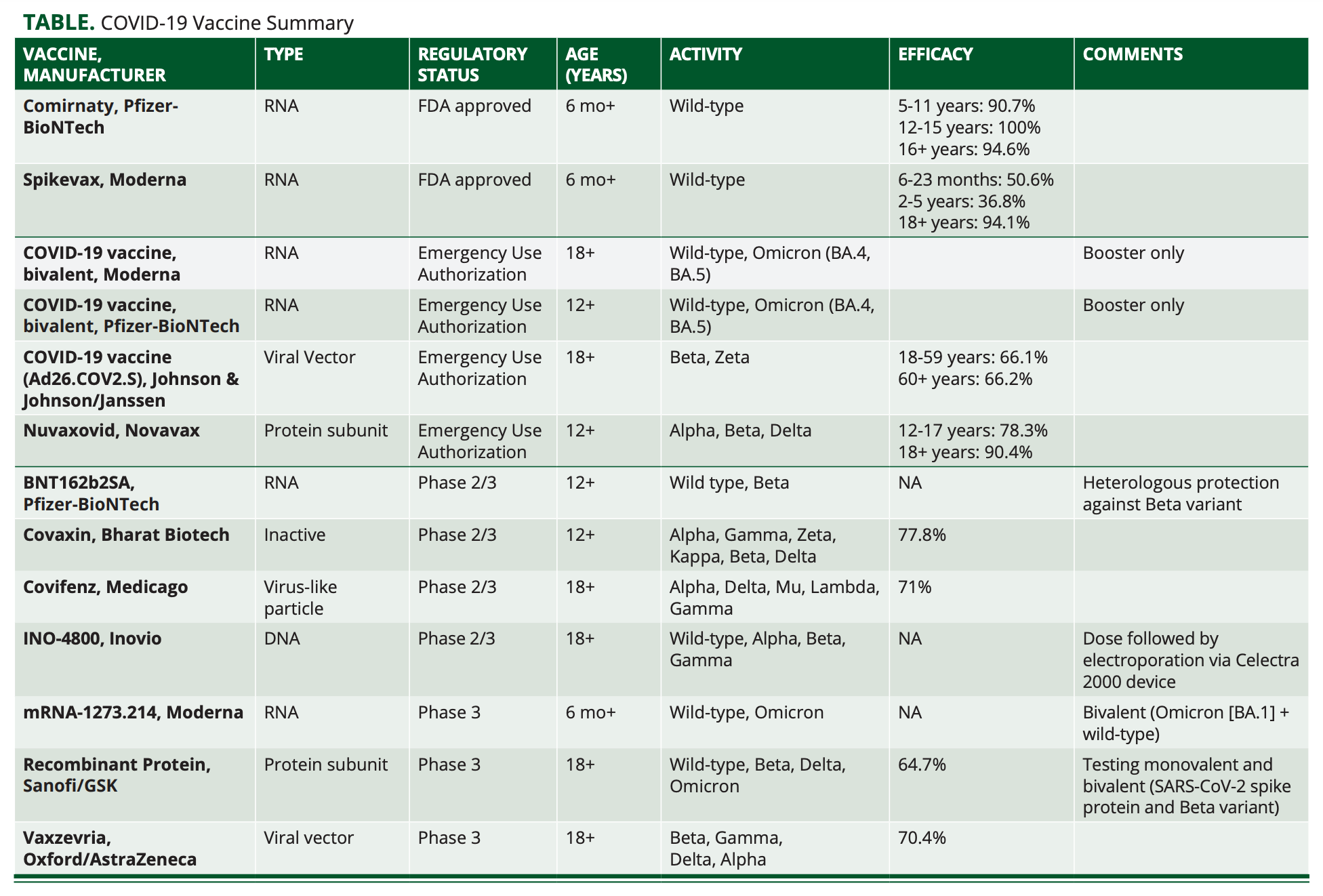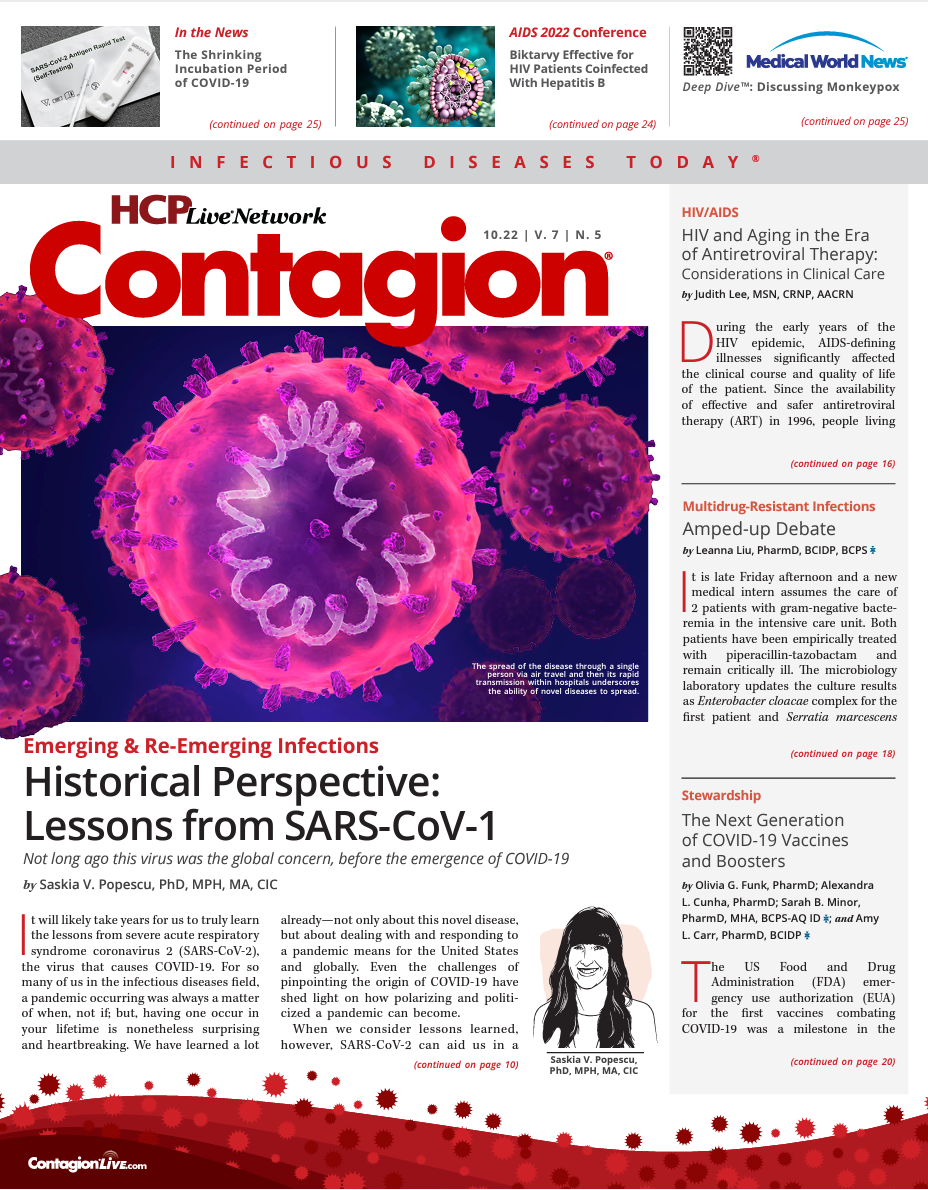The Next Generation of COVID-19 Vaccines and Boosters
Will there be an answer to keep the continuously evolving virus at bay? Are seasonal combination vaccines the wave of the future?
The US Food and Drug Administration (FDA) emergency use authorization (EUA) for the first vaccines combating COVID-19 was a milestone in the 2020 pandemic. Due to this provision, Pfizer-BioNTech’s BNT162b2 (Comirnaty), Moderna’s mRNA-1273 (Spikevax), and Johnson & Johnson/Janssen’s COVID-19 vaccine (Ad26.COV2.S) received EUAs for COVID-19 prevention in December 2020, February 2021, and June 2022, respectively. Although all 3 vaccines protect against severe illness and death following full immunization, vaccine effectiveness has declined significantly.1
Evolution of the SARS-CoV-2 virus is driven by changes in the genetic code during viral replication and has resulted in the emergence of numerous variants globally.2 Increasing resistance has reduced the efficacy of vaccines. Notably, vaccine effectiveness for preventing hospitalization dropped from more than 90% to less than 70% during the Omicron wave among patients who had received a booster dose.3
In response to the rapid decline in efficacy, pharmaceutical manufacturers began to investigate novel and updated formulations. In an effort to improve durability, the next generation of COVID-19 vaccines are being developed with an emphasis on targeting multiple mechanisms of action, leveraging vaccine combinations, and utilizing different routes of administration. As of September 2022, there are 48 COVID-19 vaccine clinical trials in the United States, including 24 vaccine candidates in phase 3 trials.4
COVID-19 vaccine development programs have studied many different types of vaccine, including RNA, viral vectors, protein subunits, virus-like particles, DNA, and inactivated virus (Table). Although the specific mechanisms of action vary depending on vaccine type, all COVID-19 vaccines simulate a benign infection by creating or mimicking SARS-CoV-2 spike proteins. This spike protein is essential for receptor binding and viral fusion.5 Receptor binding sites are responsible for the virus binding to the host cells and heptad repeat domains fusing with target cells. The prominent role of the SARS-CoV-2 spike protein in viral pathogenicity is the reason that vaccine development focuses on triggering the body to create antibodies against the spike protein.

The most widely adopted vaccine type so far has been the mRNA vaccine. Notable COVID-19 mRNA vaccines include Comirnaty and Spikevax. The RNA vaccine mechanism involves mRNA delivery inside the cells, where it provides instructions for the cell to produce a protein mimicking the SARS-CoV-2 spike protein.6 This triggers antigen expression and the host responds by producing antibodies. Both FDA-approved RNA vaccines are encapsulated in lipid particles to facilitate delivery of the mRNA to the inside of the host cells.
Another prominent type of COVID-19 vaccine is a viral vector vaccine, such as the Johnson & Johnson/Janssen COVID-19 vaccine or Vaxzevria from Oxford/AstraZeneca. Vector vaccines utilize an innocuous vector virus to create a spike protein.7 Similar to mRNA vaccines, the host’s natural cells break down the protein to express antigens and the immune system then produces antibodies targeting the foreign spike proteins. Nuvaxovid (Novavax) and the recombinant protein vaccine by Sanofi/GSK, are protein subunits in which protein antigens imitating the spike protein are administered in the body and the adjuvant assists in initiating an immune response and antibody production.8
The virus-like particle vaccines, such as Medicago's Covifenz, create innate protein structures similar to COVID-19.9 Similar to protein subunit vaccines, the adjuvant creates a stronger immune response with improved quality and durability of the response. DNA vaccines deliver plasmids into the cells, which allow the cells to create antigens to trigger an immune response.10 Inovio's INO-4800, a DNA vaccine type, employs the Cellectra 2000 administration device, which sends electrical pulses into the cell, opening cellular pores to facilitate plasmid entry to the intracellular space. Lastly, inactivated vaccines, such as Covaxin (Bharat Biotech), contain whole-virion COVID-19. Inactivated vaccines use inactivated virus to elicit an immune response.11
Although most COVID-19 vaccine innovation centers around unique mechanisms of action, vaccine development has focused on improving route and delivery systems. Most COVID-19 vaccines are administered intramuscularly, but alternate routes are being tested in clinical trials. Currently, 2 intranasal vaccines are in phase 1 clinical trials: Meissa Vaccines’ MV-014-212 and CyanVac’s CVXGA1. Unlike injection vaccines, which only generate antibodies in the bloodstream, intranasal vaccines trigger antibodies to develop in the mucosa as well.12 Mucosal immunity is mediated by IgA release, and the antibodies aid in preventing infection and reducing viral transmission. Mucosal immunity may also develop after COVID-19 vaccine delivery via the oral route.
Two vaccines by Vaxart administered as an oral tablet, VXA-CoV2-1 and VXA-CoV2-1.1-S, are in phase 1 and 2 clinical trials.4 Utilizing different routes of administration could reduce patient and logistical barriers to widespread worldwide immunization. In addition to advancements in COVID-19 vaccine administration and efficacy, there is great interest in improving the convenience of vaccine delivery.
Combination vaccines can provide protection against at least 2 diseases with 1 injection, and offer many advantages to both pediatric and adult patients. Potential benefits include fewer injections, diminished trauma, higher vaccine acceptance rates, broader protection, reduced administration costs, and less vaccine storage required.13 Although there are no official guidelines or recommendations at this time, it has been suggested that COVID-19 vaccination is likely to require an annual shot where the product for each year is matched to the circulating strains, similar to influenza.14 Both Moderna and Novavax have influenza and COVID-19 combination vaccine products in phase1/2 clinical trials. Moderna is studying mRNA-1073, a combination of Spikevax and a quadrivalent influenza vaccine.15 Novavax’s combination vaccine consists of Nuvaxovid and a quadrivalent influenza vaccine.16
Moderna is in the preclinical development phase of mRNA-1230, which is a combination vaccine for COVID19, influenza, and respiratory syncytial virus.17 Moderna has plans to make their combination vaccine available for widespread administration during the 2023 influenza season. Nuvaxovid is the latest primary COVID-19 vaccine to receive an EUA, on July 13, 2022, and more recently on August 19, 2022, was authorized for patients 12 years and older.18 Nuvaxovid demonstrated 90.4% efficacy in adults and 78.3% efficacy in adolescents against symptomatic COVID-19; however, realworld data have not yet been published. A notable concern with Nuvaxovid is that clinical trials were conducted prior to the predominance of the Delta and Omicron variants.
In response to encouragement from the FDA to update COVID-19 vaccines to include Omicron BA.4/5 components in booster doses for fall 2022, 2 updated bivalent COVID-19 vaccines were authorized for booster doses on August 31, 2022.19 The Moderna COVID-19 vaccine, bivalent, targets the same variants as Spikevax plus Omicron BA.4/5. The Pfizer-BioNTech COVID-19 vaccine, bivalent, also provides protection against the wild-type spike protein and Omicron BA.4/5.
A key difference is that the Moderna bivalent COVID-19 vaccine is authorized for individuals 18 years and older whereas the Pfizer-BioNTech bivalent COVID-19 vaccine is authorized for patients 12 years and older. Preclinical data demonstrated an active response of the vaccine against the BA.1, BA.2, BA.4, and BA.5 Omicron subvariants.20
Although the authorization of updated COVID-19 vaccines is encouraging and certain to reduce COVID-19 related morbidity and mortality, these products are vulnerable to the reduced efficacy secondary to viral mutation in the spike protein. Therefore, ongoing advances in vaccine technology remain paramount. In addition to vaccine advancements, it is important to acknowledge efforts to increase COVID-19 vaccine acceptance rates. However, controversy has existed since the COVID-19 vaccines began clinical trials.
Despite nearly 2 years of realworld clinical experience with COVID-19 vaccines and full FDA approval, vaccine hesitancy remains. As of September 7, 2022, only 77.4% of adults in the United States were fully vaccinated against COVID-19 and even fewer, 51.7%, have received their booster dose.21 Even 2 years into a global pandemic, only 61% of individuals in the United States are willing to receive a vaccine.22 As the pandemic has progressed, there have even been slight declines in vaccine acceptance rates, despite improvements in vaccine attitudes.
Overcoming the vaccine hesitancy barriers is an important step in overcoming the pandemic. As vaccine technology continues to advance, new COVID-19 variants will continue to emerge and jeopardize vaccine efficacy. Strategies to increase vaccine acceptance rates will remain a pivotal tool in the fight to end the pandemic.
References
1. Cohn BA, Cirillo PM, Murphy CC, Krigbaum NY, Wallace AW. SARS-CoV-2 vaccine protection and deaths among US veterans during 2021. Science. 2022;375(6578):331-336. doi:10.1126/science.abm0620
2. SARS-CoV-2 variant classifications and definitions. Centers for Disease Control and Prevention. Updated April 26, 2022. Accessed August 24, 2022.
3. New COVID-19 vaccine effectiveness data showcase protection gained by 3rd and 4th doses. Centers for Disease Control and Prevention. July 15, 2022. Accessed August 24, 2022. https://www.cdc.gov/media/releases/2022/s0715-COVID-VE.html
4. United States of America. COVID19 Vaccine Tracker. Updated September 14, 2022. Accessed August 24, 2022. https://covid19.trackvaccines.org/country/united-states-of-america/
5. Du L, He Y, Zhou Y, Liu S, Zheng BJ, Jiang S. The spike protein of SARS-CoV--a target for vaccine and therapeutic development. Nat Rev Microbiol. 2009;7(3):226-236.doi:10.1038/nrmicro2090
6. Spikevax. Prescribing information. Moderna US, Inc; 2022. https://www.fda.gov/media/155675/download Accessed August 24, 2022.
7. Understanding viral vector COVID-19 vaccines. Centers for Disease Control and Prevention. Updated July 13, 2022. Accessed August 24, 2022. https://www.cdc.gov/coronavirus/2019-ncov/vaccines/different-vaccines/viralvector.html
8. Information about the Novavax COVID-19 Vaccine, Adjuvanted. Novavax. Accessed August 24, 2022. https://us.novavaxcovidvaccine.com/hcp
9. Hager KJ, Pérez Marc G, Gobeil P, et al; CoVLP Study Team. Efficacy and safety of a recombinant plant-based adjuvanted Covid-19 vaccine. N Engl J Med. 2022;386(22):2084-2096. doi:10.1056/NEJMoa2201300
10. INOVIO’s COVID-19 vaccine candidate, INO-4800, provides broad cross-reactive immune responses in humans against variants of concern. News release. Inovio. April 15, 2021. Accessed August 24, 2022. https://ir.inovio.com/news-releases/news-releases-details/2021/INOVIOs-COVID-19-Vaccine-Candidate-INO-4800-Provides-Broad-Cross-reactive-Immune-Responses-In-Humans-Against-Variants-of-Concern/default.aspx
11. Sapkal GN, Yadav PD, Ella R, et al. Inactivated COVID-19 vaccine BBV152/COVAXIN effectively neutralizes recently emerged B.1.1.7 variant of SARS-CoV-2. J Travel Med. 2021;28(4):taab051. doi:10.1093/jtm/taab051
12. Live attenuated vaccines for life-threatening respiratory viruses. Meissa Vaccines. Accessed August 24, 2022. https://www.meissavaccines.com/vaccine-pipeline
13. Skibinski DA, Baudner BC, Singh M, O’Hagan DT. Combination vaccines. J Glob Infect Dis. 2011;3(1):63-72. doi:10.4103/0974-777X.77298
14. Press briefing by White House COVID-19 response team and public health officials. The White House. September 6, 2022. Accessed September 13, 2022. https://www.whitehouse.gov/briefing-room/press-briefings/2022/09/06/press-briefing-by-white-house-covid-19-response-team-and-public-health-officials-88/
15. A safety, reactogenicity, and immunogenicity study of mRNA-1073 (COVID-19/Influenza) vaccine in adults 18 to 75 years old. ClinicalTrials.gov. Updated May 17, 2022. Accessed August 24, 2022. https://clinicaltrials.gov/ct2/show/NCT05375838
16. COVID-19 + NanoFlu combination investigational vaccine. Novavax. Accessed August 24, 2022. https://www.novavax.com/science-technology/vaccine-pipeline/covid-19-nanoflu-program-combination-vaccine-candidateModerna plans combined COVID-19, flu booster shot in 2023. Nasdaq. January 18, 2022. Accessed September 7, 2022. https://www.nasdaq.com/articles/moderna-plans-combined-covid-19-flu-booster-shot-in-2023.
17. Moderna plans combined COVID-19, flu booster shot in 2023. Nasdaq. January 18, 2022. Accessed September 7, 2022. https://www.nasdaq.com/articles/moderna-plans-combined-covid-19-flu-booster-shot-in-2023.
18. Coronavirus (COVID-19) update: FDA authorizes emergency use of Novavax COVID-19 Vaccine, Adjuvanted. News release. FDA. July 13, 2022. Accessed August 24, 2022. https://www.fda.gov/news-events/press-announcements/coronavirus-covid-19-update-fda-authorizes-emergency-use-novavax-covid-19-vaccine-adjuvanted
19. Coronavirus (COVID-19) update: FDA authorizes Moderna, Pfizer-BioNTech bivalent COVID-19 vaccines for use as a booster dose. News release. FDA. August 31, 2022. Accessed August 31, 2022. https://www.fda.gov/news-events/press-announcements/coronavirus-covid-19-update-fda-authorizes-moderna-pfizer-biontech-bivalent-covid-19-vaccines-use
20. Pfizer and BioNTech granted FDA emergency use authorization of Omicron BA.4/BA.5-adapted bivalent COVID-19 vaccine booster for ages 12 years and older. Press release. Pfizer. August 31, 2022. Accessed August 31, 2022. https://www.pfizer.com/news/press-release/press-release-detail/pfizer-and-biontech-granted-fda-emergency-use-authorization
21. COVID-19 vaccinations in the United States. Centers for Disease Control and Prevention. Updated September 8, 2022. Accessed September 8, 2022.https://covid.cdc.gov/covid-data-tracker/#vaccinations_vacc-total-admin-rate-total
22. Dhanani LY, Franz B. A meta-analysis of COVID-19 vaccine attitudes and demographic characteristics in the United States. Public Health. 2022;207:31-38. doi:10.1016/j.puhe.2022.03.012

